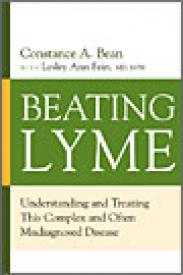TOUCHED BY LYME: "Beating Lyme"

The task for an author who wants to write a book about Lyme disease is daunting. This is due not only to the complex illness itself, which can manifest in literally hundreds of ways, but to the complicated history and politics which keep Lyme disease in a separate category from other medical conditions.
This blog has already looked at several books with different takes on Lyme disease. But the subject is nowhere near exhausted. I offer these reviews because I know people dealing with Lyme can be hungry for information.
In Beating Lyme: Understanding and Treating This Complex and Often Misdiagnosed Disease, (AMACOM, 2008) author Constance Bean uses her personal experience with the illness as a jumping off point for a broader look at the whole Lyme question. In terms of history and politics, she covers some of the same territory as Pamela Weintraub’s previously reviewed Cure Unknown. Even so, Bean explores some roads not taken by Weintraub’s book, which helps round out the reader’s understanding of the historical context of Lyme disease.
However, I think the strongest element of Beating Lyme is not the history, but the personal stories which compellingly illustrate the frustrating hoops which undiagnosed Lyme patients must jump through in trying to get proper treatment.
As she states in chapter six: For other diseases, patients do not have to go to twelve or twenty-four doctors to get their illness recognized, as they do for Lyme when it has progressed beyond the early stage. Symptoms for other diseases are accepted as being variable and involving many parts of the body. Patients with other illnesses are not told on their first visit that their symptoms are “all in their heads.” …These patients don’t have to prove their illness or the fact they are sick. Their doctors don’t challenge them with the words, “What makes you think you have multiple sclerosis?”
She explores the overlapping symptoms between chronic fatigue syndrome and Lyme disease, and explains about different brain imaging techniques like SPECT, MRI and PET scans. While these tests do not in themselves diagnose Lyme, they can give useful information that can contribute to a diagnosis.
Bean also covers such issues as antibiotic therapy, Jarish-Herxheimer reactions, insurance issues, the ill-fated Lyme vaccine and how best to prevent catching Lyme in the first place. The book’s preface is by Lyme-treating physician Lesley Ann Fein, MD, MPH.
Contact this blogger at dleland@lymedisease.org.




















We invite you to comment on our Facebook page.
Visit LymeDisease.org Facebook Page